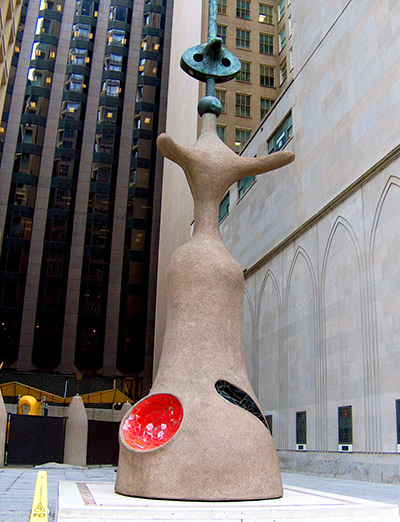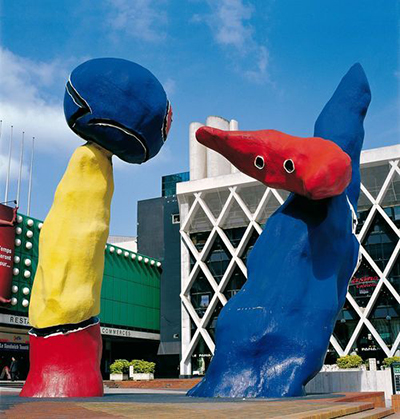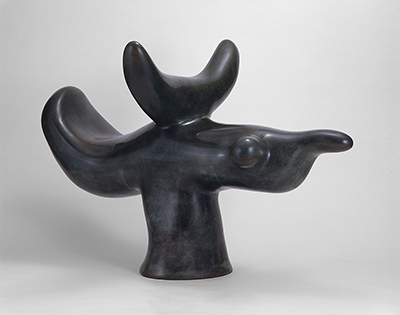The medium of sculpture offered Joan Miro an opportunity to produce three dimensional representations of his surrealist ideas, creating an extra avenue for him to express his renowned imagination and creativity.
The artist produced sculptures in a variety of sizes and materials, partly due to the differing needs of those commissioning the pieces as well as his own natural instinct to consistently try out new possibilities on regular occasions. Of his most famous sculptured artworks, the majority were designed to be displayed outside and many still remain so. Despite their extraordinary value, there has been no effort to bring them indoors and the public have repaid this faith by respecting them and leaving them relatively untouched. The same has been done for a number of other famous sculptors, including Henry Moore whose work continues to survive cold winter evenings in a number of British parks. The modern nature of Miro's style has also ensured that they still work alongside the ever changing architecture that surrounds them, despite being so much older.
There was previously a lack of focus on his sculptures as compared to the rest of his career but this has changed in recent years due to a number of notable exhibitions which have raised awareness of the qualities that this artist possessed as a sculptor. The same can be said for a number of other multi-skilled modern artists such as Pablo Picasso who himself was involved in ceramics, drawing and sculpture besides his hugely famous catalogue of oil paintings. There is also the additional factor of which art forms are easier to include in exhibitions, with many of his larger pieces being logistically unsuitable for movement away from their permanent locations. The increased competition to provide exhibitions which represent some of the biggest names in art has also led to a number of institutions delving into other mediums in which these artists were involved and addressing their careers from a different angle.
Miro's work in sculpture would develop over time, with his most ambitious pieces not arriving until he was into his fifties. He would continue to work productively in this medium into his 80's and always felt that there were new ideas and techiques to experiment with and to learn from. He was also well connected with other modern artists from across Europe over a number of decades and their creativity brought further ideas to his attention. His work across mediums grew organically where he would develop ideas and produce visual languages which could be reused on multiple occasions and sometimes repeated across different materials.
It was as early as 1946 that Miro began producing bronze sculptures for the first time. From that point onwards, he would continue to experiment and develop his knowledge in this medium right up until his death in 1983. During periods of his later life this medium would actually take precedence over his paintings which seems extraordinary considering how he still remains fundamentally remembered as an abstract painter, first and foremost. He certainly more than dabbled in sculpture, it was an exciting outlet of creativity and opportunity that he never grew tired of, despite his strong commitments to other artistic methods. He always felt sensitive about his work in mediums away from his standard paintings, and never truly considered himself established in any other areas in which he worked, despite his undoubted success and development as outlined by a number of recent exhibitions.
Large scale commissioned sculptures appeared frequently in the latter stages of artist Miro's career, resulting from the strong reputation which he had built up over the preceding decades. Miro's Chicago, or The Sun, the Moon and One Star as it was originally titled, continues to draw attention to Miro's work in this medium. It sits at 12 metres tall and continues many styles found in the artist's paintings into a more physical, multi dimensional form. Sculpture offered Miro an opportunity to experiment with all manner of media, in a way which he didn't find with painting. Steel, wire mesh, concrete, bronze and ceramic tiles were just some of the mediums used by the artist on some of his major commissions.
Miro would use seemingly value-less objects to create his sculptures, including the likes of eggs, soap bars, random scrap metal, old footballs and pebbles. The list was odd and unconnected, other than for that each was of no artistic merit or use at the point it was found by the artist. He saw possibilities that others could not and started to create consistent series of work using items such as these. This had not been done before, which is perhaps what most appealed to an artist who was famous for his rejection of the norm. The more people that would be shocked by this approach, the more he stubbornly continued. That is not to say that his work did not have merit, though, and his back catalogue of sculpture is as impressive as most famous names who specialised solely in this discipline. It also provides a stunning third dimension to his ideas that previously were restricted to canvas or paper.
Many of these items were found in and around his own studio, with the leftovers from his work in painting, sculpture and ceramics scattered across the floor. Others would also work there from time to time, adding further miscellaneous collections of discarded pieces. When taking on larger sculptures he would tend to make use of assistants in order to carry out some of the more challenging tasks and the impressive commissions that he received later in life would enable him to cover their wages without any real issue. Earlier on in his career, of course, finances were much tighter, which left restrictions on the type of work that he could produce, sometimes leaving him with no option but to return to paper, such as with his consellation series. His work as a sculptor was always several decades behind his paintings but a greater concentration on it over the last years of his life enabled it to be able to stand up in its own right, literally. Several recent exhibitions have attempted to promote Miro's sculptures more prominently and efforts have been made by his foundation to also draw attention to it more aggressively.
The Catalan first began with sculpture in 1946, by which stage he had already been awarded his very first retrospective in New York. He would continue to learn and experiment for the rest of his life, still considering himself a youthful sculptor even by the time he was 81 years of age. It certainly breathed new air into his career, though likely he would have found another new direction if he had not taken this one, such was his ability to constantly re-invent himself. Prior to 1946, he had actually attempted some forms of sculpture but these were with great passion nor quality and some claimed they were merely extensions of his paintings rather than genuine sculptures. His curious nature would inevitably return to it two decades later, with a much more successful outcome this time. He was also more able to handle the requirements of this art form, with a greater financial strength allowing him the time, space and resources that he required.
Miro worked alongside Artigas for a number of years on ceramics and this involvement inspired Miro to cast forms in bronze for the first time. It was around the early 1940s at this time. As he began to experiment with modelling and shaping clay the artist quickly realised a joy could be derived from this very personal connection between the artist and his work which he would never find possible in other art forms. Perhaps this was the initial buzz that led sculpture to become such an important part of his artistic life, having already lived so long and not really been overly involved in it. His paintings and drawings had also taken up so much time that it would have been easy for him to consider revisiting it at a later date, just as he did. His sculptures would also be slightly different in that predominantly much of the content used in them were simply found where wandering around the Spanish and French countryside, particularly mountains and the seashore. Nature combined with a sensual touch was the inspiration for Miro over a number of decades.
Catalan culture is known to be strongly ingrained in most of its citizens - see the architecture of Gaudi for further examples of this. Miro felt close to the peasants of his own region as well as the natural landscape on which they all lived. He would later produce artworks where items of normal life were embroidered into the canvas, such as fishing nets and clothing. This was his attempt to combine the beauty of painting with the tactile feeling of embroidery. Sculpture was purpose-built for artists who went beyond just the visual and once he had included real objects from his environment, there would then be an added connection with Catalonia. He also wanted his sculptured works, particularly the larger ones, to be displayed outside and perhaps even merge into nature itself as if an organic creation themselves. Those aware of his preference for this have continued to display his work in this manner, such as at the Yorkshire Sculpture Park which itself continues to hold a strong relationship with the artist's foundation.
The late 1970s and 1980s featured several large-scale commissions for the artist, located in major cities such as Chicago, Houston and Barcelona. These made us of bright colours that came from his earlier abstract paintings but there were other series of sculptures in much more subdued colour schemes. Much would depend on the original materials from which he was working as he would not want to lose all of the original qualities and appearance of them. Smaller sculptures would still retain the roughness of the materials which he found lying around where as his large commissioned pieces would tend to be more 'presentable' to the wider public, with smoother, more consistent shapes and lines. His simpler pieces were really just clever arrangements of existing objects with perhaps some additional touches of pen or paint to add some semblance of colour.
Some recent exhibitions of his work have actually placed paintings and sculptures together, where a clear link can be made. In many cases he revisited old artworks and reinvented them in a different medium. To see these displayed together is a real treat and also helps to visually explain the artist's progression rather than adding some stale explanation to the gallery wall. Those more organically-sourced pieces tended to be truly unique and the overall sequence of sculpture produced by Joan Miro across several decades is fantastically varied, but also always true to his original roots as an artist.











